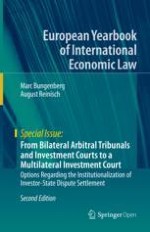
Open Access 2020 | OriginalPaper | Chapter
3. Targets for the Reorganisation of the Investment Protection Regime
Authors : Marc Bungenberg, August Reinisch
Published in: From Bilateral Arbitral Tribunals and Investment Courts to a Multilateral Investment Court
Publisher: Springer Berlin Heidelberg
Activate our intelligent search to find suitable subject content or patents.
Select sections of text to find matching patents with Artificial Intelligence. powered by
Select sections of text to find additional relevant content using AI-assisted search. powered by